Spy’s Demise (Apple II)
 The Game: Players control a spy sneaking through a building looking for secret information. High-speed elevators zoom up and down their cables throughout each floor at random intervals, making it difficult to accomplish the goal of crossing to the other side of the screen (the only way to ascend to the next floor). It takes skill, timing and nerves of steel to keep one’s spies from their demise. (Penguin Software, 1982)
The Game: Players control a spy sneaking through a building looking for secret information. High-speed elevators zoom up and down their cables throughout each floor at random intervals, making it difficult to accomplish the goal of crossing to the other side of the screen (the only way to ascend to the next floor). It takes skill, timing and nerves of steel to keep one’s spies from their demise. (Penguin Software, 1982)
Memories: An addictively fun and frustrating early entry on the Apple II computer, Alan Zeldin’s Spy’s Demise gave players some real elevator action. [read more]

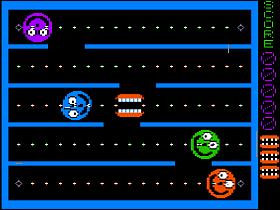 The Game: Ever had a sweet tooth? Now you are the sweet tooth – or teeth, as the case may be. You guide a set of clattering teeth around a mazelike screen of horizontal rows; an opening in each row travels down the wall separating it from the next row. Your job is to eat the tasty treats lining each row until you’ve cleared the screen. Naturally, it’s not just going to be that easy. There are nasty hard candies out to stop you, and they’ll silence those teeth of yours if they catch you – and that just bites. Periodically, a treat appears in the middle of the screen allowing you to turn the tables on them for a brief interval. Sierra On-Line, 1982
The Game: Ever had a sweet tooth? Now you are the sweet tooth – or teeth, as the case may be. You guide a set of clattering teeth around a mazelike screen of horizontal rows; an opening in each row travels down the wall separating it from the next row. Your job is to eat the tasty treats lining each row until you’ve cleared the screen. Naturally, it’s not just going to be that easy. There are nasty hard candies out to stop you, and they’ll silence those teeth of yours if they catch you – and that just bites. Periodically, a treat appears in the middle of the screen allowing you to turn the tables on them for a brief interval. Sierra On-Line, 1982 The Game: You control a round creature consisting of a mouth and little else. When the game begins, you’re given about two seconds’ head start to venture into the maze before blobby monsters are released from their cages and begin pursuing you. As you move, Munch Man leaves a trail in his wake; you advance to the next level of the game by “painting” the entire maze with that trail. (Texas Instruments, 1982)
The Game: You control a round creature consisting of a mouth and little else. When the game begins, you’re given about two seconds’ head start to venture into the maze before blobby monsters are released from their cages and begin pursuing you. As you move, Munch Man leaves a trail in his wake; you advance to the next level of the game by “painting” the entire maze with that trail. (Texas Instruments, 1982) The Game: You control a space patrol fighter cruising over the surface of a planet. Alien attackers swarm on the right side of the screen and strafe you, and you must get out of the way of their laser fire and return some of your own; the more enemy ships you allow to safely leave the screen, the more you’ll have to deal with when they re-enter from the right side of the screen. Avoid their fire, avoid colliding with them, and avoid slamming into the ground, and you might just live long enough to repel the invasion. (Texas Instruments, 1982)
The Game: You control a space patrol fighter cruising over the surface of a planet. Alien attackers swarm on the right side of the screen and strafe you, and you must get out of the way of their laser fire and return some of your own; the more enemy ships you allow to safely leave the screen, the more you’ll have to deal with when they re-enter from the right side of the screen. Avoid their fire, avoid colliding with them, and avoid slamming into the ground, and you might just live long enough to repel the invasion. (Texas Instruments, 1982)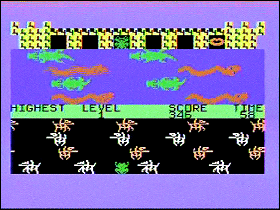 The Game: You’re a frog who has a hot date with the princess in the castle. But in order to reach her, you’ll have to cross four lanes of jousting knight traffic – avoiding the knights’ horses and lances – and then you’ll have to cross the moat on the backs of snakes and alligators, all without ending up in the drink when they submerge. (There’s also occasionally a lady frog you can hook up with en route to the castle; apparently this whole thing with the princess doesn’t have any guarantee of exclusivity.) When you reach the castle, you can hop into any open window, but if you see a pair of lips in that window, that’s where the princess is. (Romox, 1982)
The Game: You’re a frog who has a hot date with the princess in the castle. But in order to reach her, you’ll have to cross four lanes of jousting knight traffic – avoiding the knights’ horses and lances – and then you’ll have to cross the moat on the backs of snakes and alligators, all without ending up in the drink when they submerge. (There’s also occasionally a lady frog you can hook up with en route to the castle; apparently this whole thing with the princess doesn’t have any guarantee of exclusivity.) When you reach the castle, you can hop into any open window, but if you see a pair of lips in that window, that’s where the princess is. (Romox, 1982)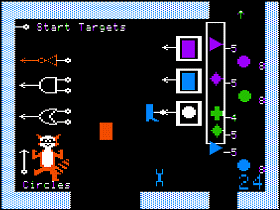 The Game: Rocky is trying to build machines to kick stuff. He provides players with a number of connectors and components, and shows them how they can be used to achieve different tasks. (The Learning Company, 1982)
The Game: Rocky is trying to build machines to kick stuff. He provides players with a number of connectors and components, and shows them how they can be used to achieve different tasks. (The Learning Company, 1982)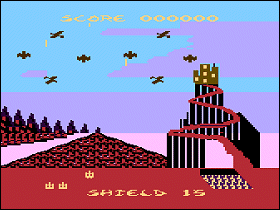 The Game: Hellish flying demons try to formation-dive your well-armed, devil-fryin’ vehicle at the bottom of the screen. Each time you knock one of this gargoylesque beasties out of the sky, they drop a piece of a bridge you must drag over to the appropriate spot on the screen. When you’re close to completing the bridge, the Prince of Darkness sends in some heavier artillery – a spooky floating demon head who spits fire at your cannon – to do away with you. Once you’ve toasted the flying meanies out of the sky and cross the bridge, it’s time to do battle with Satan himself. (CBS Video Games, 1982)
The Game: Hellish flying demons try to formation-dive your well-armed, devil-fryin’ vehicle at the bottom of the screen. Each time you knock one of this gargoylesque beasties out of the sky, they drop a piece of a bridge you must drag over to the appropriate spot on the screen. When you’re close to completing the bridge, the Prince of Darkness sends in some heavier artillery – a spooky floating demon head who spits fire at your cannon – to do away with you. Once you’ve toasted the flying meanies out of the sky and cross the bridge, it’s time to do battle with Satan himself. (CBS Video Games, 1982) The Game: The coast of 19th century China could be a dangerous place – pirates lay in wait for passing (and relatively defenseless) ships, and that’s just the obvious danger. The buyer’s and seller’s markets in dry goods, weapons, silk and opium could pose just as much of a hazard to an independent trader’s finances. And then there’s Li Yuen’s protection racket… (Avalanche Productions [designed by Art Canfil], 1982)
The Game: The coast of 19th century China could be a dangerous place – pirates lay in wait for passing (and relatively defenseless) ships, and that’s just the obvious danger. The buyer’s and seller’s markets in dry goods, weapons, silk and opium could pose just as much of a hazard to an independent trader’s finances. And then there’s Li Yuen’s protection racket… (Avalanche Productions [designed by Art Canfil], 1982)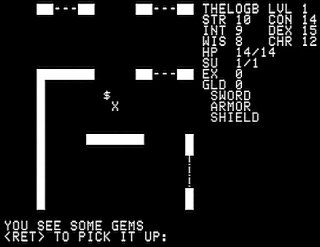 The Game: Using primitive text-based graphics, Telengard books for you a no-expenses-paid vacation through dungeons and hallways full of orcs and other nasties. If you can map the twisty passages, you might just make it back to the Adventurers’ Inn to claim your newfound experience points and heal from your many battles…and if you get lost? There are other inns out there – and many painful ends as well. (Avalon Hill, 1982)
The Game: Using primitive text-based graphics, Telengard books for you a no-expenses-paid vacation through dungeons and hallways full of orcs and other nasties. If you can map the twisty passages, you might just make it back to the Adventurers’ Inn to claim your newfound experience points and heal from your many battles…and if you get lost? There are other inns out there – and many painful ends as well. (Avalon Hill, 1982)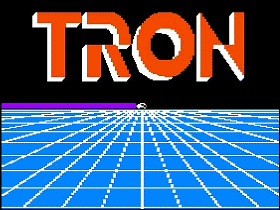 The Game: Up to two players control light cycles that leave a solid light trail in their wake. The object of the game is to trap the other player by surrounding them with a light trail that they can’t avoid crashing into – or forcing them to run into their own trail. Coming into contact with a light trail, either yours or the other player’s, collapses your own trail and ends your turn. The player still standing at the end of the round wins. (“Ivan”, circa 1982)
The Game: Up to two players control light cycles that leave a solid light trail in their wake. The object of the game is to trap the other player by surrounding them with a light trail that they can’t avoid crashing into – or forcing them to run into their own trail. Coming into contact with a light trail, either yours or the other player’s, collapses your own trail and ends your turn. The player still standing at the end of the round wins. (“Ivan”, circa 1982)